Rufous Hummingbird (original) (raw)
The rufous hummingbird is a vibrant, migratory species known for its territorial behavior and remarkable migration patterns, spanning vast distances from North America to Mexico. As one of nine species of hummingbirds in its genus, the rufous hummingbird is named for the reddish-orange coloring that most males have on their heads and chests. These feisty little birds are fun to watch as they battle for territory and rights to the bird feeder.
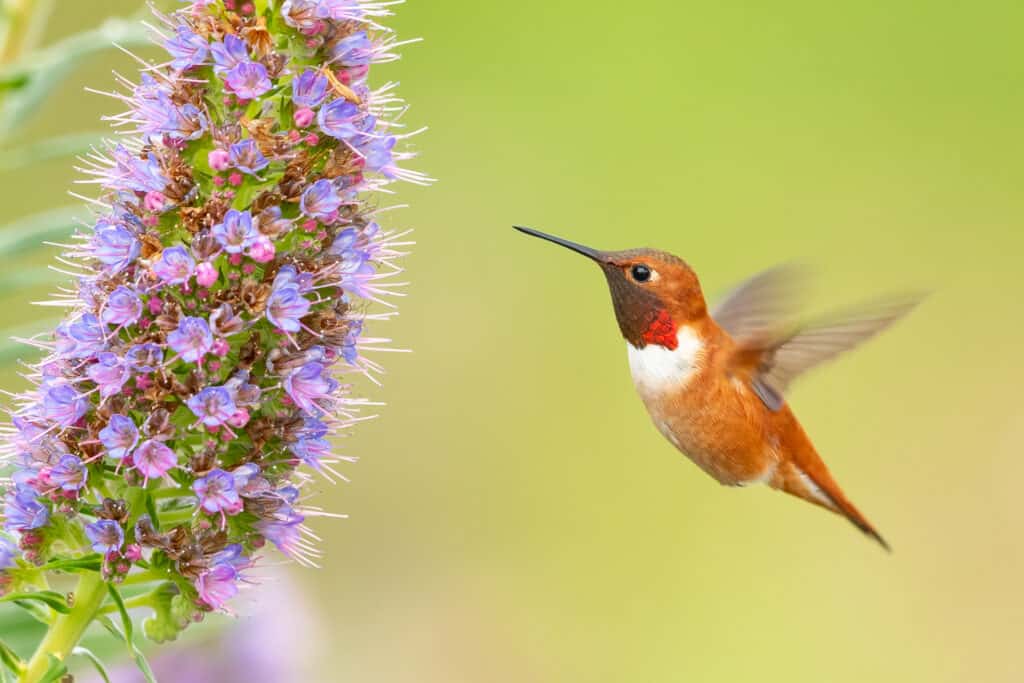
Male rufous hummingbirds are brightly colored, with a reddish-orange face.
©Keneva Photography/Shutterstock.com
Range and Migration
The rufous hummingbird is native to North America. They breed in Alaska, the Western parts of Canada, and the United States during spring and summer. They use native wildflowers in these regions as a reliable food source. For the winter, they travel almost 4,000 miles to migrate to parts of Mexico. They need a warm climate to survive and cannot overwinter in the northern parts of the continent.
Scientific Name and Species
The rufous hummingbird’ is known by the’s scientific name is Selasphorus rufus. It is one of nine species within the Selasphorus genus, which was established in 1832. It is part of the Trochilidae family, which includes around 360 species of hummingbirds. Hummingbirds are recognized by their ability to hover and feed on nectar, although they also eat insects. Their name comes from the humming sound their fast-beating wings make when they hover.
Hummingbirds belong to the Apodiformes order of birds, including Swifts and Treeswifts. It is one of the most diverse orders of birds and has more than 450 species. They are part of the Aves class, which includes all birds.
History And Evolution
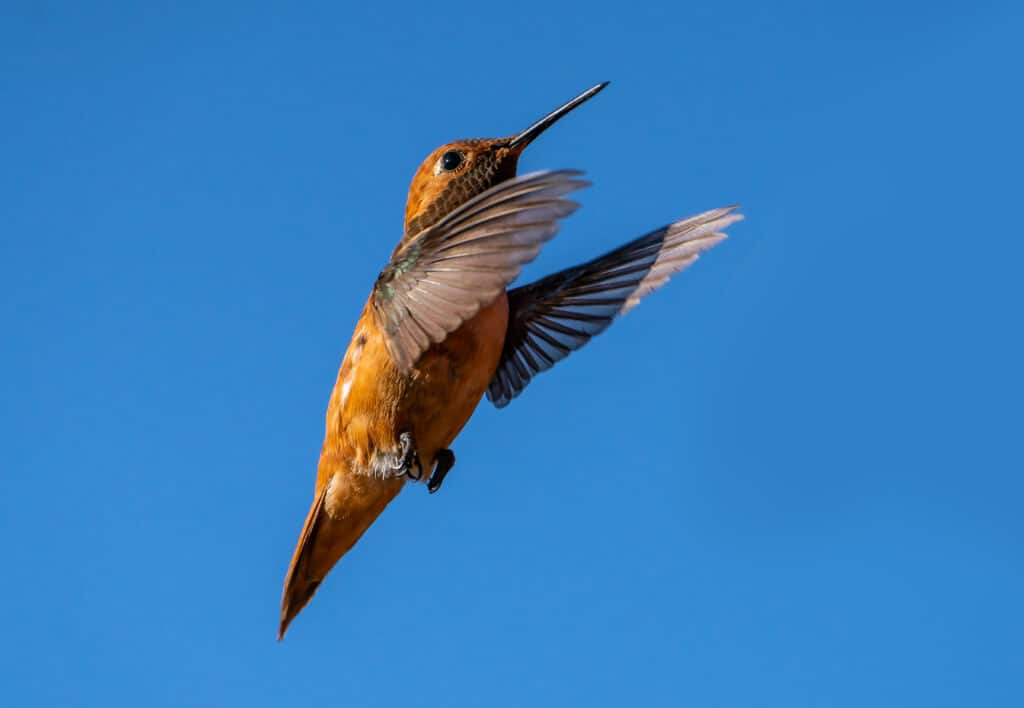
Male rufous hummingbirds can have the longest migration of any North American hummingbird and nest as far north as Alaska.
©iStock.com/Darryl Saffer
While the rufous hummingbirds are native to North America, they are part of a larger species that began in Europe around 42 million years ago, when they began to diverge from their closest living relatives, the swift. The oldest known fossil is from southeast Germany, around 30 million to 35 million years ago. However, this species became extinct in Europe, and how or why it eventually migrated to North America and South America is still unknown. The hummingbird of today evolved in the Americas about 22 million years ago.
Size, Appearance, And Behavior
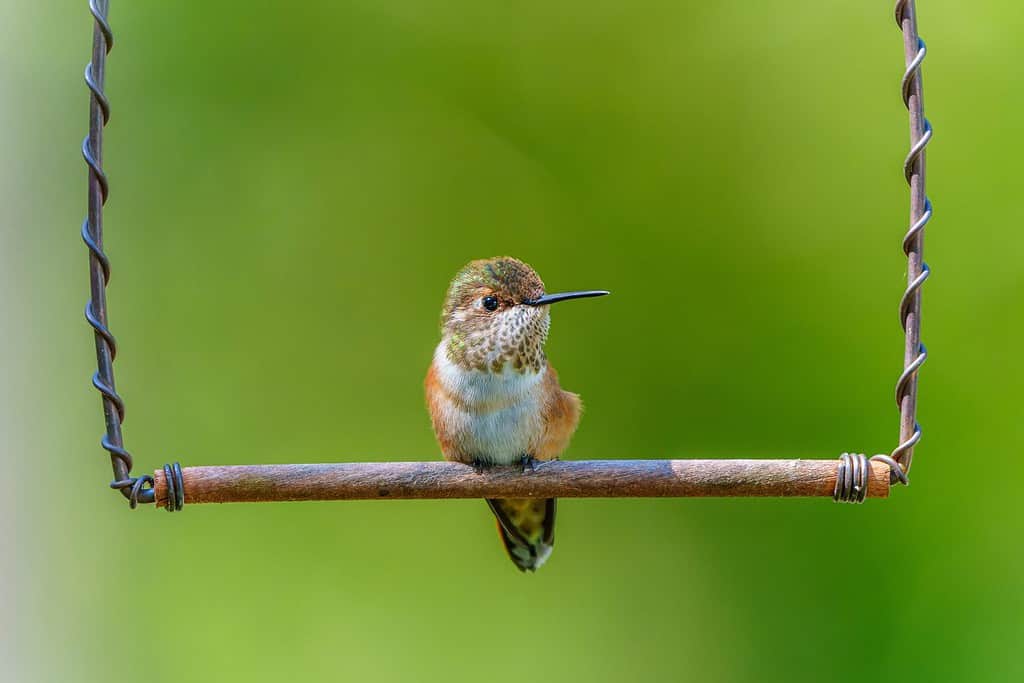
©Cliff LeSergent/Shutterstock.com
Rufous hummingbirds are around three inches long. They are not the smallest hummingbirds but represent a good example of these interesting animals. The males are brightly colored, with a reddish-orange face. This gave them their name, rufous, based on this coloring. They have white breasts and an iridescent orange patch on their throat. The Audubon Society Guide to North American Birds describes it as “glowing like a copper penny.” This helps bird watchers spot rufous hummingbirds more easily, although this iridescent coloring is unique to the males. The length of these hummingbirds usually runs 2.8 to 3.5 inches, and weight is 0.1 oz.
Some males also have green coloring on their backs or at the crown of their heads. Females more often have green coloring and are slightly larger than the males. They look similar to the Allen’s hummingbird, which also lives in many of the same places.
The rufous hummingbird is known for its aggressive and highly territorial behavior, especially during the breeding season. Despite their small size, these birds are bold and relentlessly defend their space. Males are especially fierce, often chasing away larger birds and other hummingbirds that venture too close to their favorite flowers or feeders. They can be seen darting and flying rapidly with frequent acrobatic displays. Outside the breeding season, these birds are more solitary, migrating alone over long distances between their breeding grounds in North America and wintering areas in Mexico. Their energetic nature and territory battles make them one of the most dynamic and fascinating hummingbird species to observe.
Diet and Feeding Habits
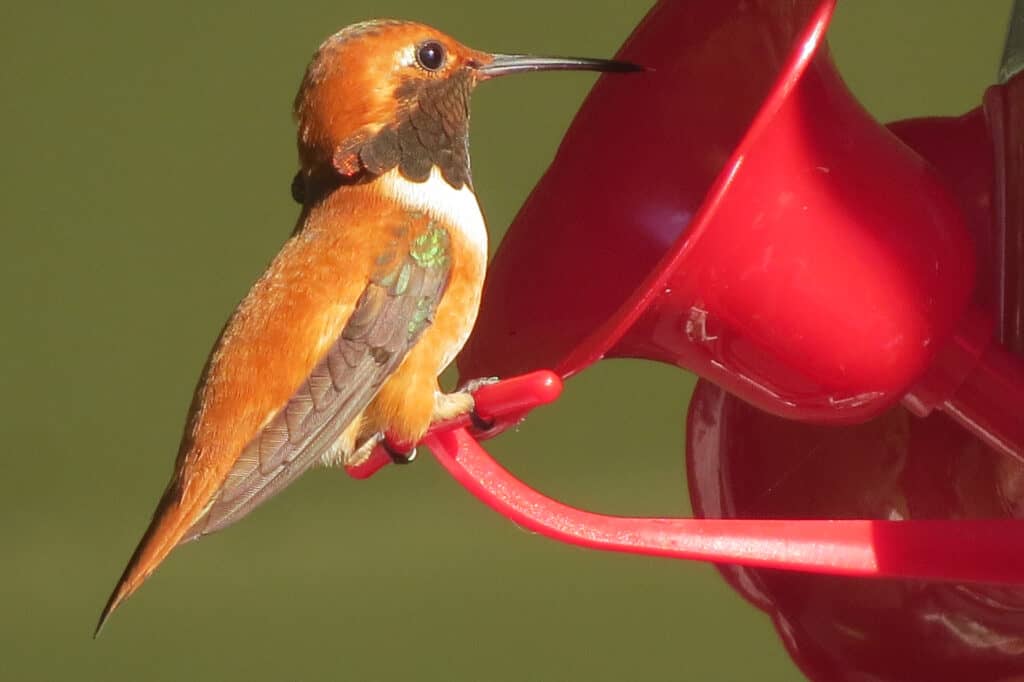
When feeding at hummingbird feeders, rufous hummingbirds like to perch if they can.
©Rachel Lambert/Shutterstock.com
Like other species of hummingbirds, the rufous hummingbird eats nectar from flowers. It uses a long proboscis and tongue to access the deep nectar in the flower’s structure. It eats insects that it catches on its wings and will also catch small insects in midair or from plant surfaces. They feed on red flowers, including penstemons, red columbines, paintbrush, scarlet sage, and gilia. Rufous hummingbirds require five times their body weight in nectar daily to maintain their energy levels.
When feeding, this hummingbird hovers in mid-air using its wings. They use downstrokes to generate lift at a greater rate than upstrokes. When feeding on sugar substances at hummingbird feeders, they perch when given the chance. This helps them conserve energy, although they do not perch for long periods of time.
Predators And Threats
Because they are small, rufous hummingbirds can be prey for other larger birds and animals. Snakes are quick to make a meal out of an unsuspecting little bird.
Other threats include changes to their habitat and food sources. Pesticides can impact the availability of insects that comprise a critical part of their diet. They are not picky regarding the type of insects they eat, although they need a ready supply. Early blooming of their flower food source can also make it hard for them to get enough to eat. They migrate, and if the flowers have bloomed by the time they reach their destination, they cannot get the nectar inside.
Climate and temperature changes are considered the biggest threats to this migratory bird. They rely on the seasons to dictate their nesting habits and provide food. If these changes occur, they can have long-term effects on the population.
Reproduction, Babies, And Lifespan
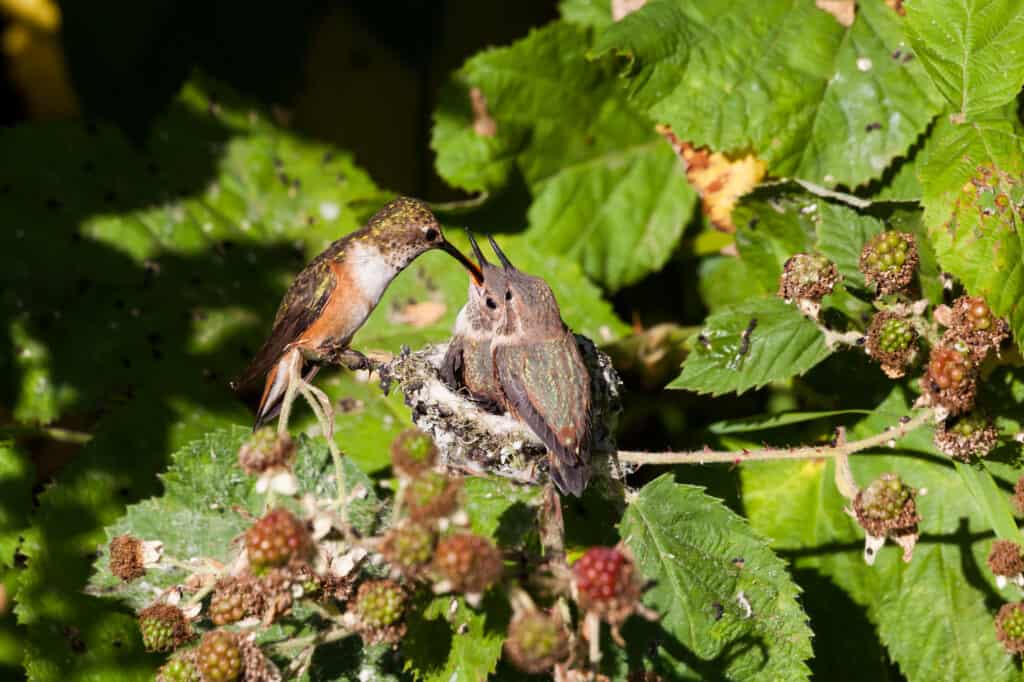
Rufous hummingbird females feed the young hummingbirds, who eventually leave the nest and fly around three weeks old.
©Feng Yu/Shutterstock.com
The rufous hummingbird’s mating season is marked by the male’s dramatic courtship displays, which often include high-speed aerial dives and rapid chases to impress females. During these displays, the male will soar upward and then plunge toward the female in a sharp, vertical dive, producing a distinct whistling sound with his tail feathers. Once a female selects a mate, the male’s role in reproduction ends, as he does not participate in nest-building or raising offspring.
The female builds a small, cup-shaped nest, typically on a branch of a tree or shrub, using soft materials like plant down, spider silk, and even bits of feathers. She lays two tiny, white eggs and incubates them for about 14 to 19 days. After hatching, the chicks are fed a diet of nectar and small insects, which provides them with the necessary energy for rapid growth. After about three weeks, the young fledges become independent and start their own journeys.
The lifespan of a rufous hummingbird in the wild typically ranges from 3 to 5 years, although many do not survive their first year due to predation, harsh weather conditions, or accidents. The survival rate for young hummingbirds is low, but those who make it past this vulnerable stage can live out a typical lifespan. The oldest known rufous hummingbird was recorded at around 9 years of age, though such instances are rare. Factors such as food availability, habitat, migration challenges, and exposure to extreme conditions can all influence their lifespan.
Population
Scientists are monitoring the rufous hummingbird population, which has been declining recently. While not listed as endangered, the International Union for Conservation of Nature upgraded it to Near Threatened in 2018 based on population numbers and observations. The Nature Conservancy Canada estimates that the population has declined by as much as 60% since data was collected in the mid-1960s.
View all 154 animals that start with R
The best visual indicator is the iridescent patch that the males have on their chests, which is reddish-orange in color. They also have recognizable reddish-orange coloring on their backs and heads, although some males and most females can also have green heads.
Like any other hummingbird or animal that feeds on nectar, Rufous hummingbirds play an important role in plant pollination. As they eat, pollen collects on their wings and body. This pollen is then carried to other plants, resulting in pollination and new growth.
All hummingbirds can get aggressive with each other over food and resources. Rufous hummingbirds will fight with other birds and animals over access to nectar as well as space at feeders.